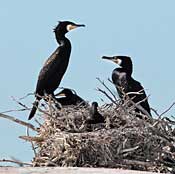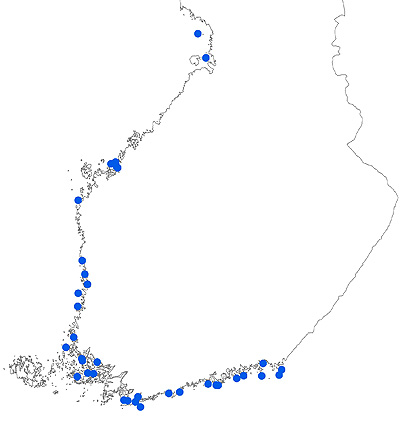Press release 2012-08-20 at 9:00
| |
|

|
|
Image: Heikki Kotiranta
|
A total of approximately 17,100 cormorant nests were found in Finland’s sea areas in the summer of 2012 – 600 nests less than in the previous summer. In contrast to other sea areas, the breeding population on the Archipelago Sea fell by 12 per cent. The breeding population fell by seven per cent in the Western Gulf of Finland, while growth of 11 per cent was observed in eastern reaches of the gulf. As a result, the total population in the Gulf of Finland remained the same.
The growth of the cormorant breeding population has slowed significantly over the last ten years. Annual growth in 2003–2007 was 47 per cent on average, but only 16 per cent in 2008–2012. Growth in the Baltic Sea population has partly been curbed by several harsh winters in central and southern Europe.
In 2012, the cormorant breeding population remained at its strongest in the Bothnian Sea (6,151 nests) and the Gulf of Finland (5,940 nests), while 3,793 nests were counted in the Archipelago Sea, 1,046 in Kvarken and 178 in the Bay of Bothnia.
The decline of the cormorant population in the Archipelago Sea and Western Gulf of Finland can be explained by the increased abundance of the white-tailed eagle. It is clear that this eagle has reduced the breeding success of cormorants in several colonies, for example in Raseborg and Luvia. White-tailed eagles have been observed eating both cormorant chicks and eggs, causing adult birds to abandon their usual breeding islets.
A total of 37 cormorant colonies were detected in Finnish sea areas, nesting on 57 islets. The six new breeding colonies were located in Raseborg, Hanko, Naantali, Pori and Nykarleby.
Cormorants protecting the common guillemot
The common guillemot, which is endangered in Finland, has become significantly more abundant in the Eastern Gulf of Finland because it shares nesting islets with the cormorant. Usually laying its eggs under rocks, the common guillemot has now been observed openly laying its eggs between cormorant nests. This prevents land carnivores, mink in particular, from destroying the nests.
Cormorant nests were illegally destroyed in at least two colonies: in Raseborg (64 nests) and Pori (12 nests). In Nykarleby, a farmed fox had been taken to a nesting islet. It destroyed the nesting sites of the endangered lesser black-backed gull, but had no significant impact on cormorant nestling production.
Two cormorant subspecies nest in Europe: the carbo on the Atlantic and the sinensis on the Baltic Sea. Over half of the cormorants hunted under special permission in the Archipelago Sea and the Gulf of Bothnia in the autumns of 2010 and 2011 were of the Atlantic subspecies. This means that hunting mainly affects migratory cormorants rather than those nesting in Finland. Part of the population of the Atlantic subspecies migrates to its wintering areas by way of the Baltic Sea, leading to its becoming common in the Finnish sea area by the latter half of August.
Development of the nesting cormorant population in Finland 1996-2012
|
|
2004
|
2005
|
2006
|
2007
|
2008
|
2009
|
2010
|
2011
|
2012
|
|
Gulf of Finland
|
1777
|
2191
|
2332
|
3054
|
3822
|
4681
|
4725
|
5877
|
5940
|
|
Archipelago Sea
|
581
|
1158
|
1611
|
3170
|
4439
|
4703
|
3586
|
4289
|
3793
|
|
Bothnian Sea
|
311
|
1047
|
1534
|
2296
|
3650
|
5649
|
5186
|
6297
|
6151
|
|
Merenkurkku/
Kvarken
|
108
|
114
|
150
|
205
|
547
|
720
|
719
|
1087
|
1046
|
|
Bothnian Bay
|
133
|
111
|
143
|
197
|
219
|
254
|
203
|
162
|
178
|
|
No. of
breeding
pairs
|
2910
|
4621
|
5770
|
8922
|
12677
|
16007
|
14419
|
17712
|
17108
|
|
Colonies
|
21
|
26
|
23
|
32
|
41
|
49
|
34
|
34
|
37
|
|
Growth rate %
|
79
|
59
|
25
|
54
|
42
|
26
|
-10
|
23
|
- 3
|
Development of the nesting cormorant population in Finland 1996-2012
|

|
|
Bigger graph
|
Nesting sites of cormorants 2012
|

|
Further infomation
Pekka Rusanen, Researcher, Finnish Environment Institute SYKE,
tel. +358 400 148 691, firstname.lastname@ymparisto.fi
Markku Mikkola-Roos, Senior Researcher, Finnish Environment Institute SYKE, tel. +358 400 148 685, firstname.lastname@ymparisto.fi
Riku Lumiaro, Information Officer, Finnish Environment Institute SYKE,
tel. +358 40 5098 654, firstname.lastname@ymparisto.fi
Images for media
Image: Heikki Kotiranta
Image: Heikki Kotiranta
Image: Heikki Kotiranta
Cormorant nesting colony in the Gulf of Finland. Image: Heikki Kotiranta